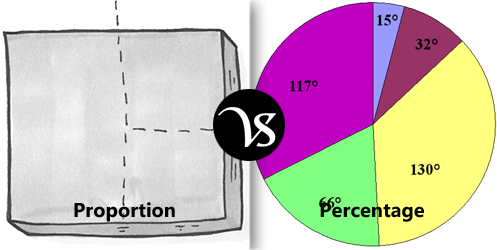 Proportion:
Proportion:
A proportion is a name which we give to the statement that two ratios are equal. It can be written in two ways:
A/B = C/D or using colon, a: b = c: d
Percentage:
In mathematics, a percentage is the number of ratio expressed as a fraction of 100. It is often denoted using the percent sign, “%”, or the abbreviation “pct.”. A percentage is the dimensionless number (pure number). Percentage is used to express how large or small one quantity is relative one to another quantity. The first quantity is relative to another quantity.
Differences:
| Basis | Proportion | Percentage |
|---|---|---|
| Definition (www.oxforddictionaries.com) |
A part, share, or number considered in comparative relation to a whole | A rate, number, or amount in each hundred |
| Synonyms | Volume, portion, share, fraction and magnitude | Rate, fee, bonus, chunk, percent |
| Antonyms | Whole, entirety, imbalance and unevenness | Juncture, whole and increase |
| Types | Its types are:
|
|
| Word origin | It was originated from Late Middle English: from Old French, from Latin proportio(n-), from pro portione ‘in respect of (it’s or a person’s) share’. | The word percentage was originated in between 1560-70; short for Medieval Latin per centum. |
| Abbreviated | It is abbreviated by : a/b = c/d |
It is abbreviated by the percent sign, “%”. |
| Pronunciation |
|
|
| Ratios | Two equivalent ratios make a proportion. | Percentage is an equivalent ratio/fraction with 100 as a denominator. |
| Example in Sentence |
|
|





